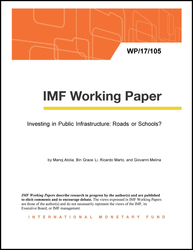
Investing in Public Infrastructure
Roads or Schools?
Why do governments in developing economies invest in roads and not enough in schools? In the presence
of distortionary taxation and debt aversion, the different pace at which roads and schools contribute to
economic growth turns out to be central to this decision. Specifically, while costs are front-loaded for both
types of investment, the growth benefits of schools accrue with a delay. To put things in perspective, with
a “big push,” even assuming a large (15 percent) return differential in favor of schools, the government
would still limit the fraction of the investment scale-up going to schools to about a half. Besides debt
aversion, political myopia also turns out to be a crucial determinant of public investment composition. A
“big push,” by accelerating growth outcomes, mitigates myopia—but at the expense of greater risks to
fiscal and debt sustainability. Tied concessional financing and grants can potentially mitigate the adverse
effects of both debt aversion and political myopia.
Publication date: May 2017
ISBN: 9781475595932
$18.00
Add to Cart by clicking price of the language and format you'd like to purchase
Available Languages and Formats
| English |
Prices in red indicate formats that are not yet available but are forthcoming.
Topics covered in this book
This title contains information about the following subjects.
Click on a subject if you would like to see other titles with the same subjects.
political myopia , debt aversion , lowincome , low-income developing countries , International Lending and Debt Problems , Institutions and Growth , Infrastructures
Summary
Copyright © 2010 - 2024
Powered by:
AIDC



